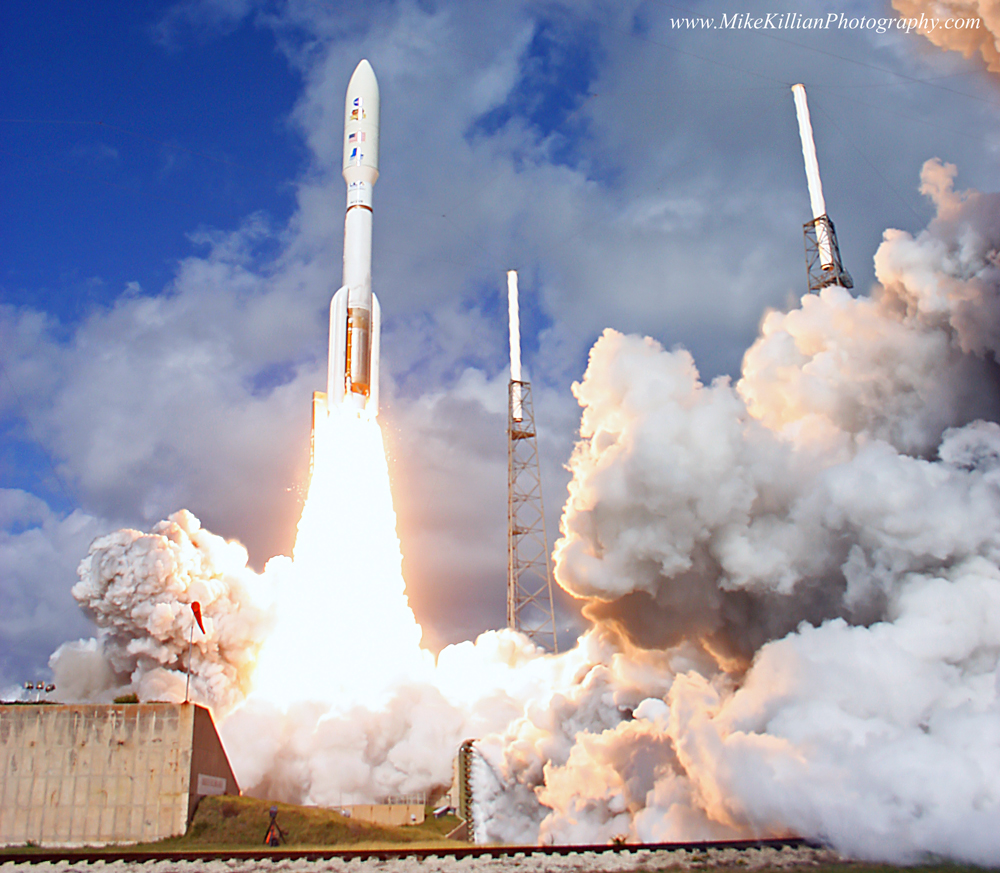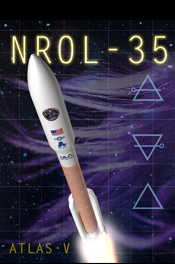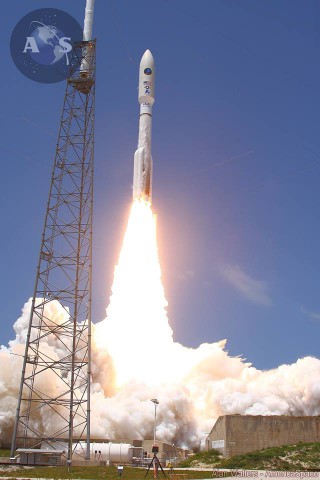
In direct contrast to last week’s triumphant and heavily publicized flight of Orion on its long-awaited Exploration Flight Test (EFT)-1, United Launch Alliance’s (ULA) next mission on the evening of Thursday, 11 December, will be shrouded in near-total secrecy, with the exact details of its approximately two-hour “launch window” having only recently been revealed. The company’s venerable Atlas V—flying in its second-most-powerful currently available variant, the “541”, equipped with a 17.7-foot (5.4-meter) payload fairing, four strap-on solid-fueled boosters and a single-engine Centaur upper stage—is scheduled to rise from Space Launch Complex (SLC)-3E at Vandenberg Air Force Base, Calif., no sooner than 7:17 p.m. PST Thursday. The primary payload for the mission is the classified NROL-35 spacecraft, to be delivered on behalf of the National Reconnaissance Office.
“Our team and mission partners have put a lot of hard work into preparing for this important mission for our nation,” explained Col. Keith Balts, commander of the 30th Space Wing at Vandenberg, who will be the launch decision authority for NROL-35. “We are looking forward to a safe and successful launch to close out an amazing year.” And, indeed, 2014 has been one of ULA’s most remarkable years on record, with Thursday’s flight marking its 14th launch in a 12-month period, the second-best all-time record for the Centennial, Colo.-based launch services company, which represents a merger between Boeing and Lockheed Martin. Since January 2014, ULA has despatched eight Atlas Vs, four Delta IVs and one Delta II. Previously, in 2009, ULA accomplished 16 launches of its Delta II, Delta IV and Atlas V vehicles.
However, 2014 will snare the record for the greatest number of Atlas Vs launched in a single calendar year. Including NROL-35, no fewer than nine of these boosters will have flown from Vandenberg and Cape Canaveral Air Force Station, Fla., delivering NASA’s latest Tracking and Data Relay Satellite (TDRS-L) into orbit in January, a Defense Meteorological Satellite Program (DMSP) in April, two classified payloads for the National Reconnaissance Office in April and May, two members of the Global Positioning System (GPS) IIF constellation, the WorldView-3 Earth imaging spacecraft in August and the secretive CLIO mission in September. Previously, the Atlas V has peaked at eight launches per annum. The most recent of its flights in 2014—the GPS IIF-8 launch on 29 October—also marked the 50th overall voyage by an Atlas V since the program’s maiden launch, way back in August 2002. With one partial failure in 50 launches, that establishes the Atlas V as one of the most impeccably reliable vehicles in operational service.

Despite the unsurprisingly quiet nature of NROL-35, some details about the spacecraft can be discerned from the choice of launch vehicle. The Atlas V 541 is surpassed only by the 551, equipped with five strap-on boosters, in terms of power and payload-lifting capability. In fact, the 541—which can deliver up to 38,450 pounds (17,440 kg) into low-Earth orbit and up to 18,230 pounds (8,290 kg) into geostationary transfer orbit—has only been used on two previous occasions: to launch NASA’s Mars Science Laboratory (MSL) and the enormously successful Curiosity rover in November 2011 and to deliver the National Reconnaissance Office’s long-delayed NROL-67 classified payload in April 2014, as detailed by Mike Killian in an expansive AmericaSpace Photo Feature.
The size and payload-to-orbit capacity of the 541 is illustrative of the magnitude of the secretive NROL-35 payload, which it has been speculated may be headed for an elliptical “Molniya-type” orbit, with a perigee of 680 miles (1,100 km) and an apogee as high as 23,360 miles (37,600 km), inclined about 62.4 degrees to the equator. Certainly, at least one source has suggested that NROL-35 may represent an upgraded “Trumpet”—also known as “Advanced Jumpseat”—Electronic Intelligence (ELINT) satellite, probably equipped with a large, deployable dish antenna for signals reception.
Whatever its exact nature, the NROL-35 payload—encapsulated within its bulbous payload fairing—was transferred to the Vertical Integration Facility (VIF) for integration atop the Centaur upper stage of the Atlas V 541 in late November. This will be the first 541 launch from the West Coast and will thus represent the most powerful Atlas V ever to fly from Vandenberg. Both of the variant’s previous launches were staged from Cape Canaveral Air Force Station, as were the four flights of the Atlas V 551 heavylifter, which lofted NASA’s New Horizons spacecraft to Pluto and the Kuiper Belt in January 2006 and the Juno mission to Jupiter in August 2011, as well as the first and second Multi-User Objective System (MUOS) satellites for the Department of Defense in February 2012 and July 2013. Another 551 is due to deliver MUOS-3 into orbit, also from the Cape, in January 2015.
However, Thursday’s launch of NROL-35 will benefit from a new variant of the engine for its Centaur upper stage, Aerojet Rocketdyne’s liquid oxygen/hydrogen-fueled RL-10C. Measuring 7 feet (2.2 meters) long and 4.5 feet (1.4 meters) in diameter, this restartable engine has a dry mass of 420 pounds (190 kg) and a maximum thrust of 23,900 pounds (10,840 kg). Although its overall thrust is slightly higher than the 22,300 pounds (10,100 kg) of the RL-10A engine currently used by the Atlas V Centaur, the RL-10C’s specific impulse is a little lower than its counterpart.
Assuming that all final processing milestones run according to plan, the Atlas V 541 will be moved to the SLC-3E launch zone, atop its Mobile Launch Platform (MLP), after which ULA engineers will establish pad connections and perform flight control system checks. On Launch Day, at about T-2 hours and 30 minutes, a built-in hold in the countdown will occur, ahead of loading cryogenic propellants aboard the Atlas’ Common Core Booster (CCB) and the Centaur. Liquid oxygen will be transferred into the tanks of the Centaur and should reach flight levels and enter a “topping” mode to replenish the effects of cryogenic boil-off by about T-64 minutes.

Meanwhile, the three-step process of fueling the CCB with liquid oxygen and a highly refined form of rocket-grade kerosene (known as “RP-1”) will get underway, proceeding through Slow Fill, Fast Fill and Topping modes. With all tanks confirmed at flight levels, the final checkout of the Flight Termination System (FTS)—which is tasked with destroying the Atlas in the event of a major accident during launch—will be performed and the ascent software, based upon the real-time weather situation on the West Coast—will be updated. Four minutes before T-0, following a final “Go-No Go” poll of all stations, the Terminal Countdown will get underway.
The vehicle will transition to internal power, and, at T-60 seconds, the Launch Control System will be enabled and the Atlas V’s computers will assume primary command of all critical functions. Two and a half seconds before liftoff, the Russian-built RD-180 engine of the CCB will roar to life, spooling up to its full 860,000 pounds (390,000 kg) of propulsive yield. Combined with the four strap-on solid-fueled boosters—each of which punches out 285,500 pounds (129,500 kg) of thrust—the most powerful Atlas V ever to fly from Vandenberg Air Force Base will be released from the SLC-3E pad surface and commence its climb-out at T+1.1 seconds.
Shortly after clearing the tower, it will execute a combined pitch, roll and yaw program maneuver to position itself onto the proper flight azimuth to inject NROL-35 into orbit. As described in the Notice to Airmen and Mariners (NOTAM) for the mission, several sea-closure areas are active until 14 December along the western coastal waters off Baja California and extend southwards into a virtually uninhabited stretch of the Pacific Ocean, far to the north-west of the Galapagos Islands, providing further evidence of the highly elliptical or near-polar nature of NROL-35’s orbital destination.
A little under a minute into the flight, with the RD-180 still burning hot and hard, the rocket will burst through the sound barrier, at which point maximum aerodynamic stresses (colloquially known as “Max Q”) will be experienced through the Atlas’ airframe. In response to this aerodynamic situation, the engine will be temporarily throttled back to 95 percent of rated performance. By about 90 seconds into the flight, the four strap-on boosters’ chamber pressures will begin to tail off and they will burn out and be jettisoned from the rapidly moving vehicle shortly thereafter. At this point in the ascent, the Atlas V will be traveling in excess of 4,500 mph (7,240 km/h).
Approximately ten seconds prior to Booster Engine Cutoff (BECO), the Atlas V will throttle down to a constant 4.6 G and the CCB will separate from the stack at about 4.5 minutes into the ascent. The turn will then come for the RL-10C-powered Centaur, which carries the key responsibility for delivering the heavyweight NROL-35 payload into its required orbit. The Centaur’s engine is capable of restarting in flight, although the exact number of “burns” it will execute to deliver its classified passenger remains unknown.
Want to keep up-to-date with all things space? Be sure to “Like” AmericaSpace on Facebook and follow us on Twitter: @AmericaSpace
Missions » NROL » NROL-35 »



Are not two RD-180 engines used by the Atlas common core?
Each RD-180 engine has two nozzles.
The RD-180 is just the RD-170 Zenit (Energia strap-on) cut in half.
RD-170—one engine, four nozzles
RD-180 One engine, two nozzles
RD-191 One nozzle